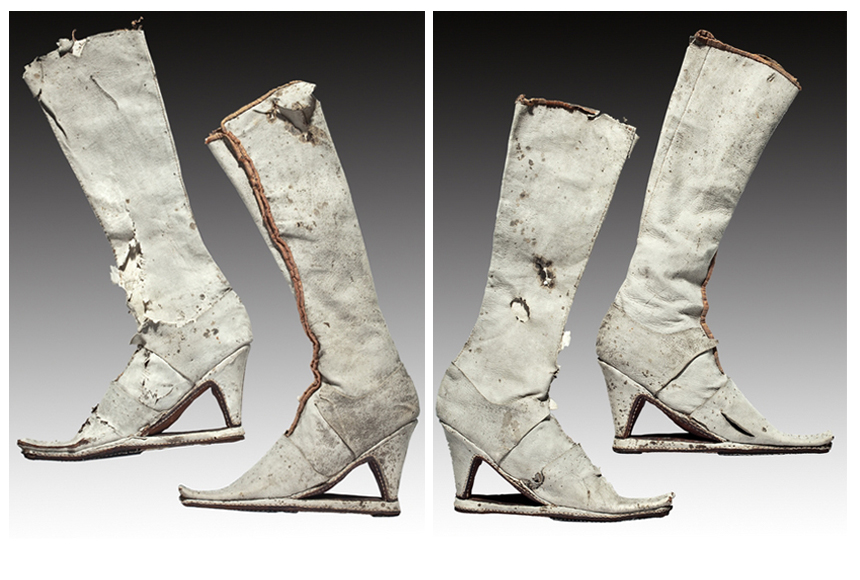These 17th-century boots, formerly in the collection of the Kunstgewerbemuseum in Wrocław (from 1867), look very stylish. They are exquisitely made of fine cream-colored suede, with extremely slender and elegantly curved shanks and narrow, elongated toes.
One can hardly imagine a leg and foot dainty enough to slide into the shoe which has no opening or lacing. By comparison, fitting into Cinderella’s glass shoe was no challenge at all! The heels are quite high and elegantly tapered. They definitely have a designer appeal, but the most striking feature is a double sole. Not only is the appearance of the boots intriguing, but they are also a product of a very interesting, inter-cultural and gender-bending development in fashion.
In the West, heels were initially found exclusively on men’s feet, where they first appeared in the late 16th c., probably inspired by Persian footwear. Worn as part of formal attire or on riding boots, heels became associated with two different expressions of masculinity: refined courtly elegance and action. The former favored covered heels, while the more sturdy stacked heels were appropriate for active pursuits, be it hunting or war. Seventeenth-century fashion for high boots for men (ca. 1620-1690) reflected the influence of military dress. Let’s remember that it was a very tumultuous period, marked by lengthy wars (like the Thirty Years’ War of 1618-1648) and numerous military campaigns, and also by exploration of distant lands. Boots became part of the male uniform for military conquest and global exploration. Some scholars credit the oriental-inspired Polish boot with bringing this fashion to the West. Interestingly, in the earlier 17th c., the most fashionable boots were made of fine suede rather than tough leather.
Seventeenth-century men’s boot featured quite high heels. The heel helped to secure the foot in stirrups. Boots often featured a slap-sole, an extra-sole attached to the toes only, so that the foot could be placed in stirrups but when walking, the heel was prevented from getting stuck in mud. A pair of 17th-century men’s boots with slap-soles used to be kept in the sacristy of the Church of the Blessed Virgin Mary in nearby Legnica and cherished as allegedly worn by St Hedwig, patron saint of Silesia. Never mind that she had lived in the 13th c. and was keen on going barefoot as a form of mortification of the flesh!
Combining exoticism, equestrianism, military attire, and (literally and metaphorically) elevated status, heels were an exciting accessory. As the 17th c. wore on, these qualities made heels of interest to women as well.
The boots in the Museum’s collection, a very rare and precious specimen, were definitely made for a woman. Women’s fashion favored covered heels and tapered, narrow toes. The shoes show how the practical solutions were borrowed from men’s boots for aesthetic effect. The auxiliary sole as not a slap-sole as it is firmly attached to the toes and to the heel. The women’s fashion for high heels and for boots in particular was regarded as quite controversial at the time because it questioned social norms. The boots in our collection were certainly a true fashion statement. The wearer must have been a woman of means, elegance, and daring.
Women’s boots with a double sole, Silesia, 2nd half of the 17th c.
Małgorzata Możdżyńska-Nawotka, Department of Dress and Textiles
— #stayathome – more entries ➸
